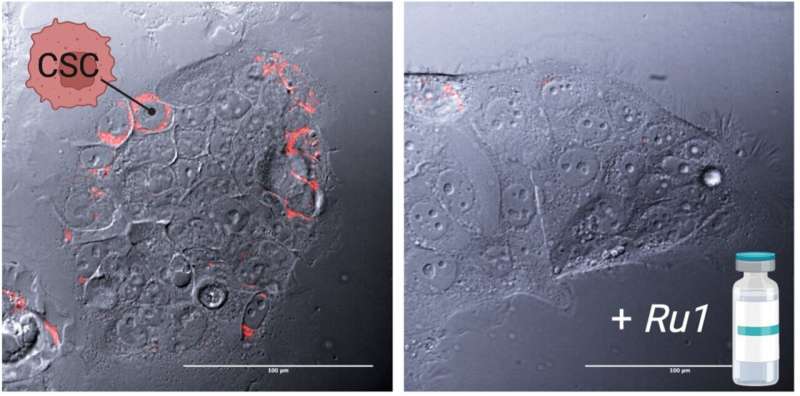This article has been reviewed according to Science X's editorial process and policies. Editors have highlighted the following attributes while ensuring the content's credibility:
fact-checked
proofread
Scientists develop a new type of anti-cancer agent

Many cancer therapies, in addition to producing numerous side effects, fail to achieve complete tumor remission, partly due to the presence of cancer stem cells, which are difficult to eradicate. These cells can self-renew and play a key role in tumor recurrence and metastasis processes, so there is significant interest in developing therapies that target this subset of tumor cells.
A collaboration between chemists from the Center for Research in Biological Chemistry and Molecular Materials (CiQUS), led by Prof. JL Mascareñas, and cell biologists from the CSIC (Instituto de Investigaciones Biomédicas Sols-Morreale, IIBM CSIC-UAM, Madrid), led by Dr. Bruno Sainz, has led to the discovery of a new class of compound that targets cancer stem cells and reduces their potential to generate tumors.
For some years, Prof. Mascareñas' laboratory has been conducting basic research on certain molecules based on metal complexes that can interact very selectively with DNA. These findings have allowed Dr. Sainz's group to conduct extensive studies with mice implanted with patients' tumors, demonstrating a powerful antitumor effect of these complexes. The scientists have demonstrated anticancer effects in pancreatic, colorectal, and osteosarcoma tumors, with low secondary toxicity, and studies on other types of cancer are currently underway.
The new research is published in the Journal of Experimental & Clinical Cancer Research.
Cancer stem cells rely on mitochondrial respiration to survive and evade the immune system's defenses, which represents a metabolic Achilles' heel. Mechanistic studies carried out this time suggest that the new compound, called Ru1, promotes a decrease in the expression of genes necessary for this respiration, the main energy source for these cells, causing them to lose their cancerous potential. Dr. Sainz's group has also demonstrated that combined therapies with other antitumor agents are possible, resulting in additive effects.
The project is currently in an advanced stage for its transfer and preclinical valorization.
More information: Sonia Alcalá et al, Targeting cancer stem cell OXPHOS with tailored ruthenium complexes as a new anti-cancer strategy, Journal of Experimental & Clinical Cancer Research (2024). DOI: 10.1186/s13046-023-02931-7




















